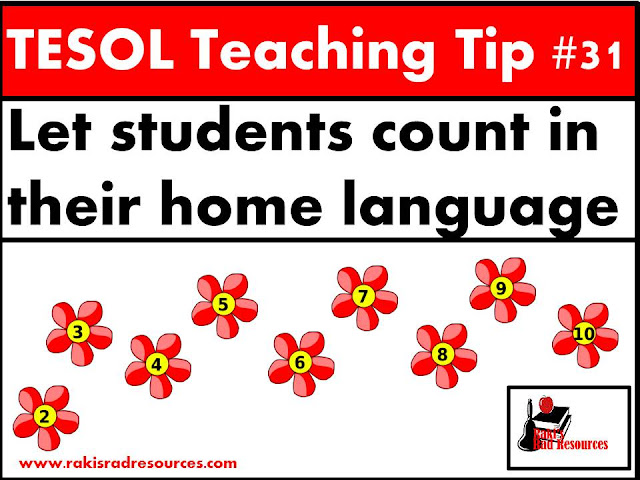My class this year consisted of 20 students, of which only 1 spoke English only in his household, and even he began his life in a bilingual environment. The other 18 spoke at least one, if not two other languages in their homes, and go to school in English, although they don’t live in an English speaking country. Due to my unique teaching position, I have had some readers ask for tips on teaching English Language Learners. Here’s this week’s Tuesday TESOL Teaching Tip:
ELL Teaching Tip #31: Let Them Count in Their Home Language
In addition to teaching English Language Learners, I also live with an English Language Learner. English is my husband’s fifth language. He speaks: Arabic, French, Spanish, Russian and English – in that order. He can read, write, count, and do math in all of his languages. He spends 90% of his day in English, thinks and dreams in English. But, hand him a stack of papers and ask him to count and tell you how many papers there are and he will count the papers in Arabic every time. Now, after he’s done counting in Arabic, he will tell me the total in English, but his brain
 automatically counts in Arabic. He says by counting in Arabic he doesn’t have to think about the numbers and worry about the possibility of miscounting.
automatically counts in Arabic. He says by counting in Arabic he doesn’t have to think about the numbers and worry about the possibility of miscounting.Many of our English Language Learners are like my husband. They learned basic concepts like counting and understanding numbers in their home language before they learned English. Depending on when they started learning English, they may also have learned basic operations and other math skills in their home language. Asking students to convert all of their math skills into English is time consuming for you and them, and it increases the possibility of errors. For this reason, I allow and encourage my students to count, add, subtract, and any do any other math operations they learned in their home language in their home language. However there are a few things in Math that I ask them to do in English:
1.) Give the answer (first by writing, and eventually orally)
2.) Read and understand what the problem is asking for
3.) Explain their thinking
If my students can do these three things in English, I don’t feel that saying “eight x four = thirty two” is more important than saying “ocho veces quatro es igual a treinta y dos”. In fact, by allowing them to do the work in their home language, students are often able to better understand the vocabulary and concepts that make math in English hard for them.
Do you let your students count in their home language?
 Do you enjoy the weekly TESOL Teaching Tips? Would you like to view an hour long presentation on this topic? I recently presented on Strategies for Teaching English Language Learners at the Everything’s Intermediate Expo. Now you can grab the presentation for just $3.95 from Teacher’s Notebook.
Do you enjoy the weekly TESOL Teaching Tips? Would you like to view an hour long presentation on this topic? I recently presented on Strategies for Teaching English Language Learners at the Everything’s Intermediate Expo. Now you can grab the presentation for just $3.95 from Teacher’s Notebook.Find more TESOL Teaching Tips here, and come back every Tuesday for a new tip!



Wow! This was an interesting post for me. I guess I never thought how my students were getting their answers. Almost all my students last year spoke another language at home: Somali or Arabic mostly. Every once in awhile I heard kids mumble Somali words when working or conversing with classmates and I learned the Arabic number and math words when they reviewed/learned them in their Arabic class. But, it wasn't something I watched or encouraged. Having had one student fresh from Egypt, I suppose she did most math in her head in Arabic, but when I worked with her I would count in English.
ReplyDeleteYou're right though- if the three things that you look for are what I want to see too. If they best understand it in their home language(s) and can communicate with me in English, why force them to do it another way. Next year, with Kindergartners, I will watch for this and help bridge number sense with what they already know and the English vocabulary that matches it.
Thanks for the thought-provoking post! I appreciated it!
Ms. M,
DeleteI'm glad this post was thought provoking for you. Since you mentioned Kindergarteners, I wanted to mention something I observed with my 1st graders last year. I had a few kids who couldn't count past 10 or 11 in their home language, and couldn't count pretty much at all in English. At first, I kept pushing them to count in English, but it just wasn't working. So, I stepped back and took a couple of small group sessions to teach them how to get to 100 in their home language. Then, went back to counting in English, and all of a sudden those that never learned to count in their home language could now make the connection to English and started counting very well. Granted, I had to teach myself to count in Arabic before I could do this - but it was amazing to see the difference once they had mastered the skill in the language they thought in.
BTW - Where do you teach? It sounds like you have a wonderfully diverse environment.
Heidi Raki
www.rakisradresources.com